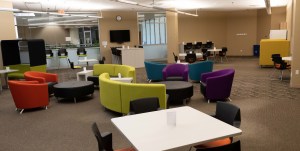As university campuses reopen, remote work could take many forms

Just as in other industries, higher education institutions’ plans on how and when to bring employees back to the office depend largely on the individual employees, higher education leaders said Tuesday during an online panel hosted by the consulting firm Deloitte.
Student experience and making sure the faculty and staff needed for student needs are accessible on-campus are the top priorities, but decisions about other workers, who may have realized their jobs can be done entirely remotely and gotten used to working from home, are still in progress, university leaders said during the event. They also said they’ll need to balance allowing employees flexibility with making sure there are structures in place to encourage collaboration and assess productivity.
“Pullback to that status quo [of in-person work] is going to be extremely strong across higher education is particularly as people get vaccinated, and that fear maybe subsides a little bit,” University of Southern California Vice President of Strategy Tim Bessolo said. “We’re really viewing this as an opportunity to challenge that status quo. We’re looking at the lessons we learned over the past year and thinking really strategically about what our work, the workforce and the workplace is going to look like in the future.”
At the University of Chicago, each business unit will put forward a plan on what its work will look like, said Brett Leibsker, the institution’s associate vice president of human resources. And a committee of representatives from human resources, budget, facilities, IT and legal departments will consider the plans, he said.
“We’re asking our managers to take a look at this return to work process and to enter the conversation from a place of empathy, to understand what employees have been through over the past 14 months and find a way to sum to balance work and and personal lives as best we can,” he said.
It’s a message that was reflected in comments from the more than 100 viewers of the panel. In a polling activity, 98% of participants advocated for flexible work, as opposed to fully online or in-person. Flexible work, they said, would allow for a better work-life balance. When asked some of the challenges that came with fully remote work, poll participants noted that it was difficult to turn off from work while working from home.
Daren Hubbard, the chief information officer for the Georgia Institute of Technology, said during the event that the pandemic prompted universities to try out various collaboration tools and frameworks that had seen limited use before the health crisis. Remote employees miss out on “water cooler chat” or being able to easily stop by their boss’ office, Hubbard said, but the university found there were benefits to building out online collaborative tools, like people being able to tune into an event more easily if they can’t make it in person.
“As we think about our workspaces are being configured and how we are going to continue to offer support to our students, we also need to think about the employee and where they fit in to that that continuum in terms of the work-life balance,” Hubbard said. “Then [we need to offer] just the opportunity to engage and to feel like they’re being supported, or to advance in [their] career.”
Currently, employee assessments are designed to be in-person, Hubbard said, so universities will need to redesign how performance is measured.
Assessing how a hybrid employee works could mean focusing on outcomes, said Deb Dunbar, the director of talent and organization development at Indiana University. That means management setting expectations for how each employee performs and then offering support to get them to that goal depending on whether they’re working online, hybrid or in-person.
“One of the things I’ve always said is: ‘It is possible to sit in a chair in an office all day for eight hours and do nothing,'” she said. “I mean, it takes a lot of effort, but it is possible. And it’s possible to not be seen in a remote environment and get a whole lot done.”




